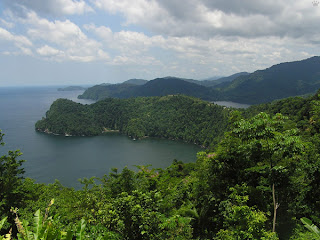Trinidad and Tobago
Welcome to the first post in my blog on the islands of Trinidad and Tobago which are located in the Caribbean Sea off the coast of Venezuela. The history of these islands is where I will start my journey through them, for it is an interesting story to be told with many twists and turns along their paths.
So let us start with Trinidad, which according to history was "discovered" by Christopher Columbus on his third voyage in the year 1498. When Columbus first saw this land according to Bartolome De Las Casas " he named this land the island of Trinidad, because he had determined to give the first land he discovered that name " (1). This naming was based on the view that was formed with three mountains that were connected to one another and this could have been viewed, in that religious time frame, to be associated with the Holy Trinity. There was very little that interested the Spanish crown on the island for there were no minerals to be found and it took about 30 years to even appoint a governor for the island. In 1530 a conquistador, Antonio Sedeno , was to be Captain-General of Trinidad for life (2). This was a short lived occupancy for the island which would not have its first permanent settlement until about one hundred years later with the establishment of San Jose de Oruma. To assume that this island was unoccupied up until this point would be a mistake but that my friends is a story for another time.
So we continue our journey over to the island of Tobago, which was also "discovered" by Christopher Columbus on his third voyage, but he never landed on the island and no attempts were made to colonize Tobago (3). It was a separate entity from Trinidad until much later into the history of European settlement of these islands. It was named for " the tobacco cultivated by the original Carib population " (4) and was a much fought over piece of land due to the harbour and the fertile soil of the island by indigenous populations of the area. These attributes would come into play heading into the 1600's with European powers fighting over the soil, the harbour, and the peoples that occupied this island.
This may have been a little boring and stuffy for you as the reader of this, yet is is important to understand the beginnings of these islands from the different perspectives that we will encounter along our journey. This particular blog entry shows us the popular story told from a European perspective but there is another side to these beautiful islands and other stories to be told. So I hope that you will continue on this journey with me as we explore through time the life that these islands have taken on within the unwritten and written records of human existence.
(1) Symcox, Geoffrey, and Blair Sullivan, ed. Christopher Columbus and the Enterprise of the Indes: A Brief History with Documents. Boston: Bedford/St. Martin, 2005.
(2) http://www.discover-tt.com/trinidad/history.html
(3) http://gotrinidadandtobago.com/trinidad-tobago-history/
(4) http://gotrinidadandtobago.com/trinidad-tobago-history/


No comments:
Post a Comment